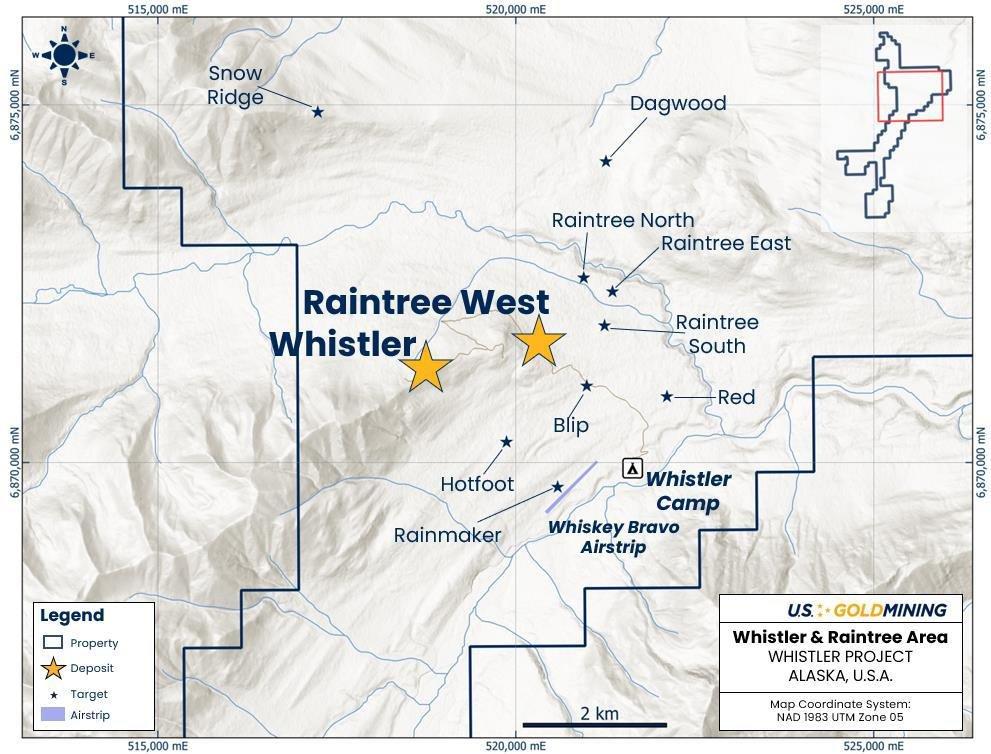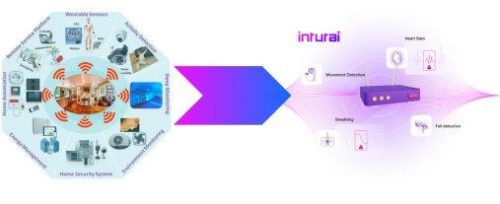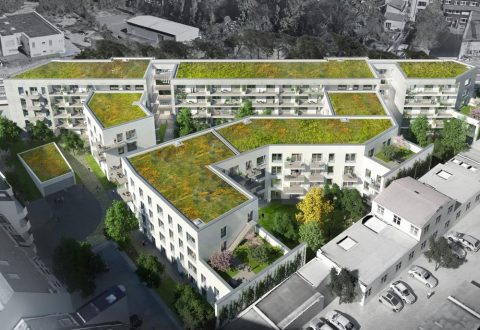
U.S. GoldMining Intersects 652.5 meters at 1.00 g/t Gold Equivalent From Near-Surface Confirming Continuity of High-Grade Core at the Whistler Gold-Copper Deposit, Alaska
Highlights:
- Whistler Deposit: WH23-03 re-entry of an initial hole drilled in 2023 further extended the previously reported mineralization intercept:
– Continuous high-grade core of 5 meters (m) at 0.73 grams per tonne (g/t) gold (Au), 0.16% copper (Cu) and 1.5 g/t silver (Ag), or 1.00 g/t gold equivalent (AuEq)*, from 7.0 m to 659.5 m down hole;
– Also contained several higher-grade zones, including:
- 0 m at 1.55 g/t AuEq from 131.0 m downhole; and
- 0 m at 1.36 g/t AuEq from 575.0 m downhole.
– Total mineralized envelope comprises 716.6 m of mineralization at 0.68 g/t Au, 0.15% Cu and 1.4 g/t Ag, or 0.93 g/t AuEq, from surface to 717 m below surface.
- The initial hole (drilled in 2023) included a previously reported interval of 547 meters at 1.06 g/t AuEq (see news release January 16, 2024).
- Raintree Open Pit: WH24-01 intersected broad Au-Cu-Ag porphyry-style mineralization
– 4 m at 0.53 g/t AuEq from 311 m depth
- Including 41.0 m at 0.61 g/t AuEq from 321 m depth; and
– In addition, narrow vein-style Au-Ag-base metal mineralization:
- 0 m at 0.78 g/t Au, 171.6 g/t Ag, 1.19% lead (Pb) and 2.53 % zinc (Zn) from 249 m depth.
– The Raintree Deposit remains open along strike and to depth with further drilling planned to delineate the full extent of mineralization.
- The Company has recently completed its 2024 drilling season for a total drill program exceeding 4,005 meters for the season.
* AuEq equations are calculated consistent with the methodology outlined in Whistler Project technical reports “S-K 1300 Technical Report Summary Initial Assessment for the Whistler Project, South Central Alaska” with an effective date of September 22, 2022, available under the Company’s profile at www.sec.gov, and technical report titled “NI 43-101 Mineral Resource Estimate for the Whistler Project, South Central Alaska” with an effective date of September 22, 2022, available under the Company’s profile at www.sedarplus.ca. Specifically: below 10 g/t Ag: AuEq = Au + Cu*1.5733 + 0.0108*Ag, and above 10 g/t Ag: AuEq = Au + Cu*1.5733.
Tim Smith, Chief Executive Officer of U.S. GoldMining, commented: "The 2023 drill program returned the longest drill intercept of consistent mineralization ever recorded at the Project: 547.2 meters at 1.06 g/t AuEq in WH23-03. We are further encouraged that we have now extended this by an additional +100 meters to enlarge the continuously mineralized intercept within the Whistler deposit high-grade core to 652.5 meters at 1.00 g/t AuEq. At Raintree, the drilling has returned both porphyry and vein-type mineralization, which both remain open along strike and to depth, warranting additional follow-up exploration. I want to acknowledge our professional and hard-working field teams that executed the 2024 exploration program safely, without a single lost time incident to date, and delivered on budget and ahead of schedule.”
2024 Drilling Program
As reported on June 27, 2024, the Company commenced diamond core drilling at the Raintree West deposit, before moving to the Whistler deposit in early July (see Figure 1).
The initial confirmatory infill drill hole at Raintree West aimed to elucidate the geological model and to also provide the potential to expand the existing resource. Confirmatory drill hole WH24-01 was drilled into the area of the mineral resource estimate constraining pit shell for the Raintree West Open Pit deposit, with the objective of collecting additional information about the style, geometry, continuity and controls on mineralization hosted therein.
Drilling at the Whistler deposit was aimed at further delineating and extending areas of high–grade mineralization to depth, building upon the success of the 2023 drilling program. Previously, WH23-03 was abandoned due to winter freeze-up in late October 2023, at 600.2 meters depth. Subsequently in July 2024 our drilling contractor successfully re-entered the drill hole and extended core sampling to 874.5 meters depth. Porphyry style mineralization was intersected to a depth of 717 meters within the drill hole, at which point it encountered barren country rock peripheral to the porphyry mineral system. WH23-03 assay results have further increased confidence in the continuity of mineralization within the Whistler deposit’s core of high-grade mineralization, which extends to surface and remains open to depth.
Drilling Results Discussion
Whistler Deposit
Combining assay results for both the original core drilled in 2023 to 600.2 m downhole, and the 2024 re-entry and coring extended to 874.5 m downhole, Whistler drill hole WH23-03 intersected 716.6 m at 0.93 g/t AuEq from just below shallow soil cover at surface (0.41 m depth) to 717.0 m downhole. Gold, copper and silver mineralization was relatively consistent throughout the length of the overall intercept, with several zones of higher grade mineralization encountered including:
- 5 m at 1.00 g/t AuEq, comprised of 0.73 g/t Au, 0.16% Cu and 1.5 g/t Ag from 7.0 m depth to 659.5 m down hole. This interval included several higher-grade intercepts
– 0 m at 1.55 g/t AuEq from 131.0 m depth; and
– 5 m at 1.10 g/t AuEq from 373.5 m downhole; and
– 0 m at 1.36 g/t AuEq from 575.0 m downhole.
The Whistler Deposit is hosted within the Whistler Intrusive Suite, a composite of diorite stocks and dykes that divide the suite broadly into an early Main Stage Porphyry ("MSP"), a later Intermineral Porphyry Suite ("IMP") and a late intrusive phase referred to as the Late Stage Porphyry ("LSP"). Gold and copper mineralization is characterized by abundant disseminated sulphide and quartz + sulphide vein stockworks (including classic porphyry diagnostic ‘A’, ‘B’, ‘D’, and ‘M’ type veins), and potassic alteration which is variably overprinted by later phyllic alteration. The early-stage MSP suite is most strongly altered, veined and mineralized, with the IMP being less intensely altered and veined but remaining consistently mineralized, and the late or post-mineralization LSP generally containing below cut-off grade or being unmineralized. In addition, the Company’s technical team has identified the presence of a robust core of higher-grade mineralization within the deposit that correlates with intense alteration and B-veining within MSP in the eastern part of the intrusive suite.
WH23-03 infilled an area of previously sparse drilling on the southern margin of this ‘high-grade core’, with a corresponding lower-confidence resource classification. WH23-03 drilled at a steep angle on the southern margin of the high-grade core, aimed at improving confidence in grade continuity and achieving maximum depth penetration. The drill hole was designed to test for potential expansion of mineralization below the base of the current mineral resource constraining pit shell. WH23-03 demonstrated remarkable consistency of mineralization within the high-grade core, with near continuous mineralization encountered from surface to 717 meters depth, where it intersected barren country rock and LSP. The lower half of the drill hole intersected mineral resources currently classified as Inferred, thereby improving confidence in the geological model.
Raintree West Deposit
WH24-01 comprised a confirmatory drill hole into the Raintree West Open Pit deposit, targeting potential extensions of porphyry-style and distal (possibly epithermal) vein-style mineralization previously encountered in drilling. The drill hole also planned to extend below the existing mineral resource estimate constraining pit shell to test the interpreted presence of a shallow dipping fault that may offset the near surface (open pit) and deeper (underground) portions of the Raintree West deposit.
Drilling confirmed two styles of mineralization:
- Porphyry-style mineralization is predominant, comprising diorite-hosted A & B type vein and disseminated mineralization.
- WH24-01 intersected 61.4 m at 0.53 g/t AuEq, comprised of 0.36 g/t Au, 0.09% Cu, 4.4 g/t Ag.
– Within this interval, elevated lead and zinc to 0.14% Pb and 0.39% Zn respectively, correlates to overprinting late galena and sphalerite bearing veins.
- Porphyry-distal (possibly epithermal) veins containing abundant silver, lead and zinc, with variable gold and copper. Several intercepts were noted throughout the drill hole, including:
- 0 m at 0.33 g/t Au, 0.07% Cu, 42.0 g/t Ag, 0.33% Pb and 0.75% Zn, including a higher grade interval of;
– 0 m at 0.78 g/t Au, 0.22% Cu, 171.6 g/t Ag, 1.19% Pb and 2.53% Zn.
WH24-01 provided the first oriented core data within the Raintree deposit, the structural data from which is being analyzed to help with improving future iterations of the geological and resource model, and to vector towards potential extension of mineralization. Both the porphyry-style and vein-style mineralization remain open along strike and to depth throughout the Raintree area.
Technical Information
Tim Smith, P.Geo., Chief Executive Officer of U.S. GoldMining, has supervised the preparation of this news release and has reviewed and approved the scientific and technical information contained herein. Mr. Smith is a "qualified person" as defined in Canadian National Instrument 43-101 – Standards of Disclosure for Mineral Projects.
For details of the Whistler Gold-Copper Project mineral resource estimate see technical report “S-K 1300 Technical Report Summary Initial Assessment for the Whistler Project, South Central Alaska” with an effective date of September 22, 2022, available under the Company’s profile at www.sec.gov, or technical report titled “NI 43-101 Mineral Resource Estimate for the Whistler Project, South Central Alaska” with an effective date of September 22, 2022, available under the Company’s profile at www.sedarplus.ca.
Data Verification
For the Whistler Project drill core sampling program, samples were taken from the NQ/HQ core by sawing the drill core in half, with one-half sent to Bureau Veritas Commodities Canada Ltd. ("BV") in Fairbanks for sample preparation, then to BV’s analytical laboratory in Vancouver, Canada for assaying, and the other half of the core is retained at the site for future reference. Sample lengths downhole were generally 2.0 m, except where samples were taken to honor geological contacts.
BV is a certified commercial laboratory and is independent of U.S. GoldMining. The Company has implemented a quality assurance and quality control program for the sampling and analysis of drill core samples, including duplicates, mineralized standards and blank samples for each batch of core samples. The gold analyses were completed by lead collection fire assay fusion with AAS finish (FA430 method) on 30 grams test weight. Copper, silver and other base metals (total suite of 45 elements) assays were assayed by 4-acid digestion and ICP-MS analysis (MA200 method) on 0.25 grams test weight.
About U.S. GoldMining Inc.
U.S. GoldMining Inc. is an exploration and development company focused on advancing the 100% owned Whistler Gold-Copper Project, located 105 miles (170 kilometers) northwest of Anchorage, Alaska, U.S.A. The Whistler Project consists of several gold-copper porphyry deposits and exploration targets within a large regional land package totaling approximately 53,700 acres (217.5 square kilometers).
Visit www.usgoldmining.us for more information, including high resolution figures.
Swiss Resource Capital AG
Poststrasse 1
CH9100 Herisau
Telefon: +41 (71) 354-8501
Telefax: +41 (71) 560-4271
http://www.resource-capital.ch
Chief Executive Officer
Telefon: +1 (833) 388-9788
E-Mail: info@usgoldmining.us
CEO
Telefon: +41 (71) 3548501
E-Mail: js@resource-capital.ch
Telefon: +41 (71) 354-8501
E-Mail: mo@resource-capital.ch
![]()




